For those of you who have a pool filter that is somewhat, shall we say, marginal, this post is for you. Many pool filters out there are either too small for the pool, not extremely efficient, or they’re just plain worn out. Others work fine for most of the year, but may have trouble during spring clean-up or warmer temperatures. Even if your filter is brand new, correctly sized, and you’ve never had an issue, you can never go wrong with improving the efficiency of your pool filtration. The only consequence is you’ll have cleaner, clearer water. That doesn’t sound so bad, does it?!
If you’re looking to get the best performance of your swimming pool filter, we’ve got a few tips you can use on your cartridge, sand, or D.E. filters.
Is Your Filter the Right Size?
Before we get into the different ways to improve filtration efficiency in your pool, consider whether or not your filter may be undersized. As a general rule of thumb, there’s no such thing as too big of a filter, only one that’s too small or just right. To pick the right size of filter, consider the flow rate of your pump and the size of your pool. You’ll find more information about filter sizing in our blog post, How to Size a Pool Filter.
Cartridge Pool Filters
A cartridge pool filter has one or more pleated cartridges. The water is forced into the pleats. Here, it leaves behind dirt and debris, which gets trapped within the folds. As the pressure rises on the filter tank gauge, the flow rate decreases. Eventually, the cartridge is removed, hosed clean, and the cycle begins anew.
If dirt and debris end up back in the pool, it may be bypassing your filter cartridge. Look for rips in the pleats or cracks in the plastic ends of your cartridge. Another cause of dirt getting around the cartridge (and not through it) are misplaced or misaligned parts within the filter. Look to your filter’s owner’s manual to identify the location and placement of internal manifolds. Check these internal parts for cracks or missing o-rings. Sometimes it’s just a matter of properly “seating” the cartridge into the base of the filter tank before you put the lid back on.
You may notice that your filter cartridges lose efficiency over time. This is because each time you clean your cartridge, the fibers become looser and it loses just a bit of its filtering ability. After around 20 cleanings, or every 2-3 years, consider replacing your filter cartridges with new ones. In the meantime, there are a few things you can do to improve pool filtration and keep the filter running as efficiently as possible:
3 Ways To Improve Cartridge Pool Filter Performance
1. Filter Cleaner
The best treatment for overworked filter cartridges is to regularly use Granular Filter Cleaner. Soak your filter cartridge overnight to take cleanse pleats that are clogged with minerals or oily residue. After soaking, rinse the cartridge thoroughly, and reinstall. If you struggle with lots of oily substances in the pool (suntan oil, cosmetics, hair products, natural body oils, etc.), use a pool enzyme product, such as Pool Perfect, to break them down and prolong the life of your filter media.
2. Water Clarifier
Adding a clarifier to your pool water can help pool filters immensely. Pool clarifiers act as coagulants, clumping very tiny particles together into larger clumps that are more easily filtered. Be careful not to overdose, however. Using too much clarifier can cause the opposite effect, dispersing the particles and make your water appear cloudy. As with any pool chemical, carefully read and follow all product label instructions before adding to the pool.
3. Pulp Fiber
Adding a small amount of Jack’s Magic Filter Fiber Stuff to your skimmer can help your pool filter cartridge to trap more fine dirt and debris. You just need a small amount, only 3 oz. per 25 sq. ft. of filter area. Do NOT use DE Powder or Perlite in your cartridge filter, because these have very sharp edges that can cut the microscopic fibers of your filter fabrics, damaging the filter beyond repair.
Sand Pool Filters
Sand pool filters are the simplest to operate, the easiest to maintain, and often the least expensive to purchase. Even those intimidated by their pool equipment can manage to backwash a sand filter. Sand filters have a simple design. Water is pumped into the top of the tank, pushed through the sand bed, then it flows into the slotted pipes in the bottom of the tank. The dirt is left behind, trapped in the sand bed. To remove the dirt, reverse the flow and backwash it out of the filter tank.
Sand filters are not perfect, however, and they lack the same level of efficiency as you’ll find in a cartridge or D.E. filter. Sometimes sand filters can allow very fine debris to pass through, but your can improve the filtration ability in your pool with a few simple methods.
If you notice that your filtering efficiency has gone completely out the window, it probably has to do with the sand itself or a problem with the filter internals. Just like with the cartridge filter, you may need to check for cracks and signs of damage, especially if you’re noticing sand in the pool. If the sand is older than 5 years, consider replacing it with new sand or a suitable alternative like Zeo-Sand.
Other common issues with sand filters include mud-balling, which is when oily balls of sand collect at the top of the filter. Remove the balls by hand, and replace the amount with fresh filter sand. Sometimes you can also eliminate the balls with Granular Filter Cleaner, which we mentioned in the previous section. If the pump is too powerful for your filter, channeling in the sand can cause the water to pass through unfiltered. Also, if your water is particularly hard, your sand may form rock-hard calcified chunks that reduce filtration ability.
3 Ways To Improve Sand Pool Filter Performance
1. Filter Cleaner:
Sand filter cleaners work a bit differently than D.E. and cartridge filter cleaners, in that they can be stronger and harsher against oily buildup and calcification without damaging the filter media (sand). You’ll also use them a bit differently. For best results, use Sand Filter Cleaner before every backwash, letting it soak in for a few hours or overnight if possible.
2. Aluminum Sulfate:
Known as Alum in the trade, Aluminum Sulfate forms a gelatinous material when mixed with water. You can often find it at your local pool supply store or online. Use 1 pound of Alum per square foot of pool filter area, and add it slowly into the pool skimmer. This brings the material to the sand bed, where it will spread out and stop. Water then passes through the layer of Alum, leaving behind the very small particles that ordinarily would not be filtered out.
3. The Slime Bag:
Using the Slime Bag is almost like adding a secondary filter to your pool. All sand filters will bypass very fine, silty dust, and this is normal. Use the Slime Bag for quick spring clean-up, algae recovery, or when dealing with small mudslides. The Slime Bag is a fine mesh fabric filter bag that attaches to wall returns. If you don’t have a Slime Bag to use, you can always wait for the dust to settle (Alum helps!), then vacuum to waste.
Diatomaceous Earth Pool Filters
D.E. pool filters are known to be superior to the other two types of pool filters in terms of their particle size filtering ability. The biggest downside is that they’re the most expensive type of filter to buy, and they are a bit more work to maintain. But these factors pale in comparison to the filtration efficiency you’ll get with a D.E. filter. Even though it’s the best type of pool filter available, you can still improve its filtration abilities.
If your D.E. filter isn’t working so well, it requires frequent backwashing, or if you’re noticing D.E. powder blowing into the pool, there are a few things you can do. First, remove the grid assembly from the tank and hose it off thoroughly. If it’s extremely dirty and clogged, soak it in D.E. Filter Cleaner or Filter Perfect. Inspect the grid assembly for signs of damage, like fabric rips, manifold cracks, or a missing air bleeder, and replace parts as needed. Check the o-ring on top of the standpipe inside the tank to make sure it’s not missing. Also check the multiport or push-pull valve for cracks and worn o-rings/gaskets.
Place the grids back into the tank, and add the correct amount of D.E. powder through the skimmer. Since you just finished a complete cleaning, you’ll need a “full charge” of powder, which is more than what you use after a simple backwashing.
3 Ways To Improve D.E. Pool Filter Performance
Enzymes
Cellulose Fiber
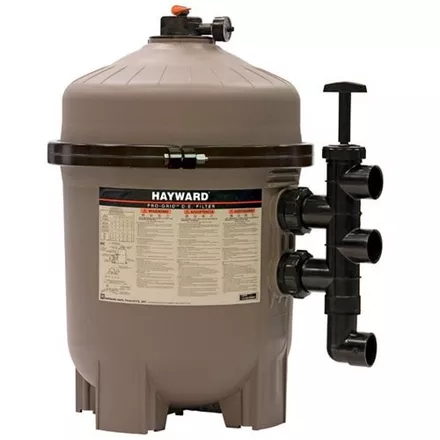
Filter Bumping
1. Pool Enzymes
Oils can be a problem in any pool filter, but can really clog up the fabric used in D.E. filter grids. Using an enzyme product like Pool Perfect will remedy the situation. They use the same types of enzymes for ocean oil spills, so you know it’s good stuff that can handle heavy duty jobs.
2. Cellulose Fiber:
Cellulose is an alternative filter powder for use in D.E. pool filters, replacing diatomaceous earth. Volcanic in origin, Cellulose is all-natural. It provides greater surface area, offering greater coverage with less bridging between grids and more complete backwashing. Cellulose is also lighter than D.E., meaning it’s easier to handle.
3. D.E. Filter Bumping:
This one’s not a product, but rather a method. Hayward Perflex filter owners are familiar with “bumping” the filter. But if you have a multiport or slide valve on your D.E. filter, this may be a new concept. It’s a way to lower filter pressure, raise water flow, and improve D.E. filtration ability.
Bumping a non-Perflex filter is just a very short backwash, only for 5-10 seconds. It’s just long enough for D.E. powder to begin discharging into the waste line. Next, turn off the pump, and place the valve back into the filter position. You will notice lower filter pressure when you turn the pump back on again, but should not have lost much D.E. powder (if so, add a cup or two). For a more complete D.E. filter bumping, do the filter-backwash-filter process two or three more times, all very briefly.
These are just a few of the ways you can easily improve filtration efficiency and boost the ability of your pool filter. As you’ll notice, some of the products listed are suitable for any filter. The main exception is that a few are only useable for certain filter types. If you are having trouble with water clarity, but the pool is well balanced and sanitized, look to the filter. There’s a chance that the filter could be the source of your water clarity problems!

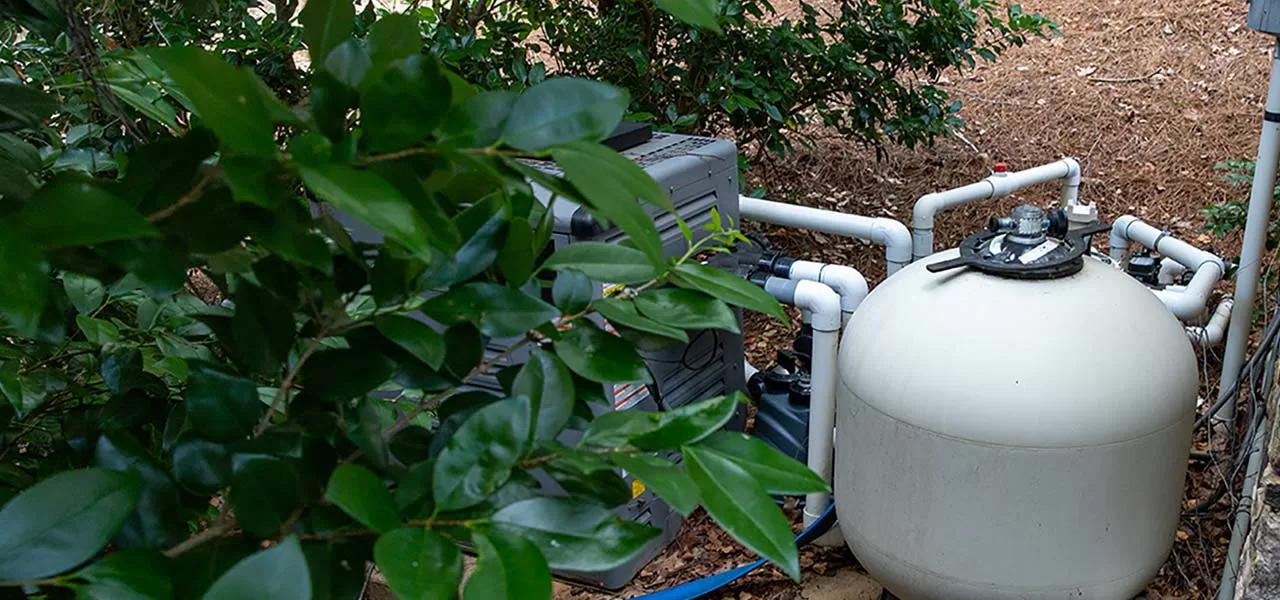

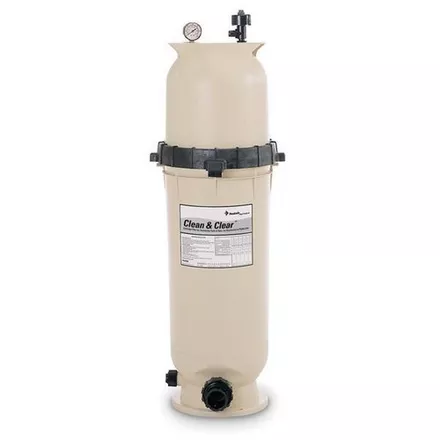
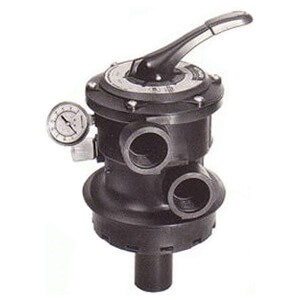
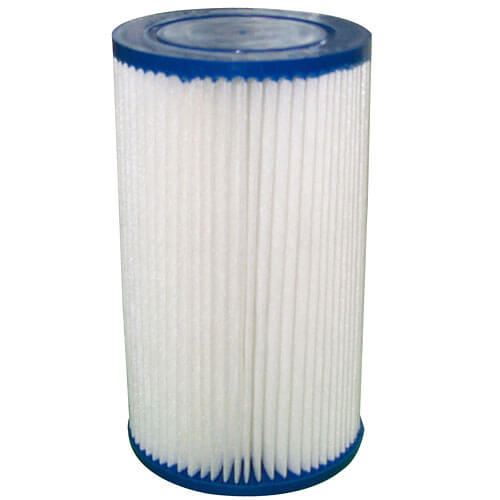
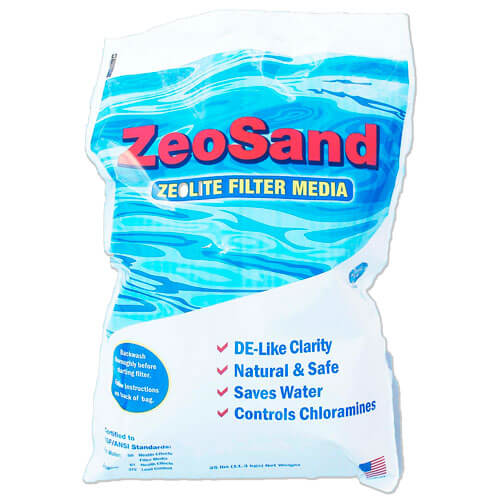
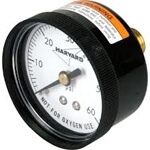
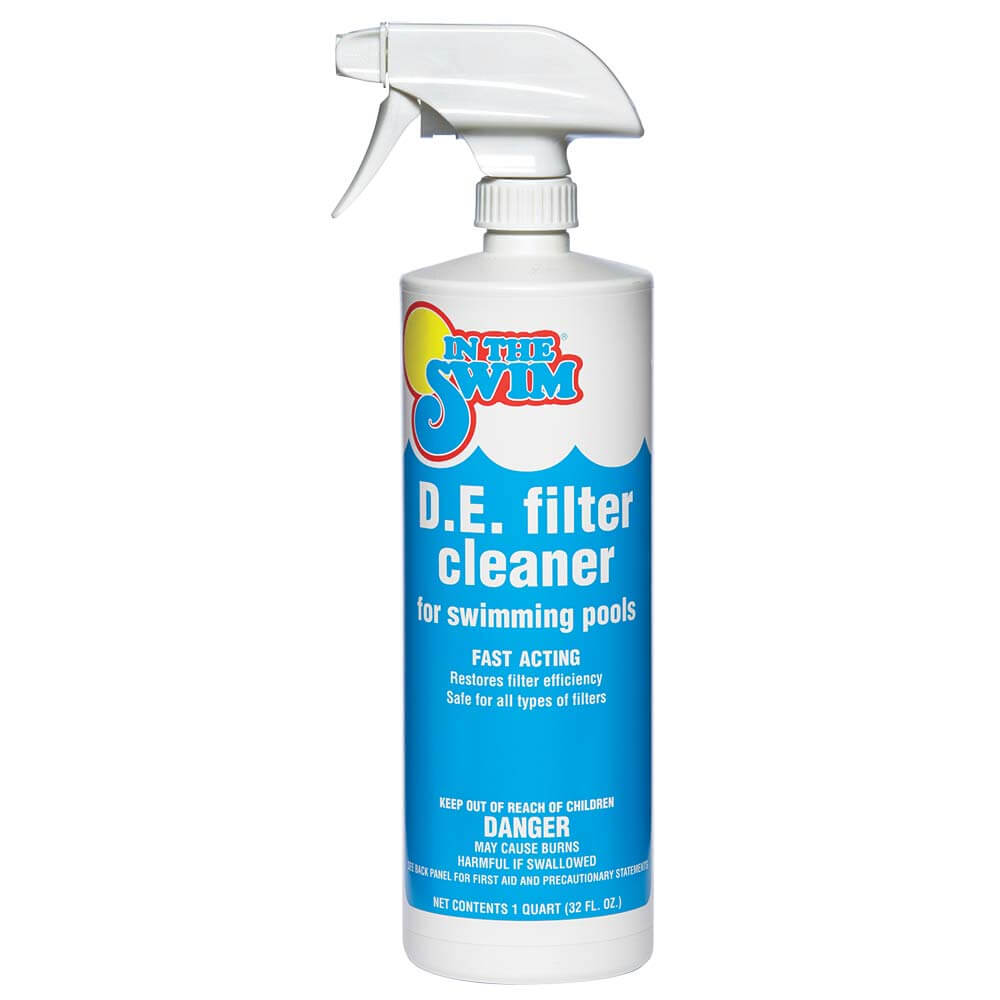
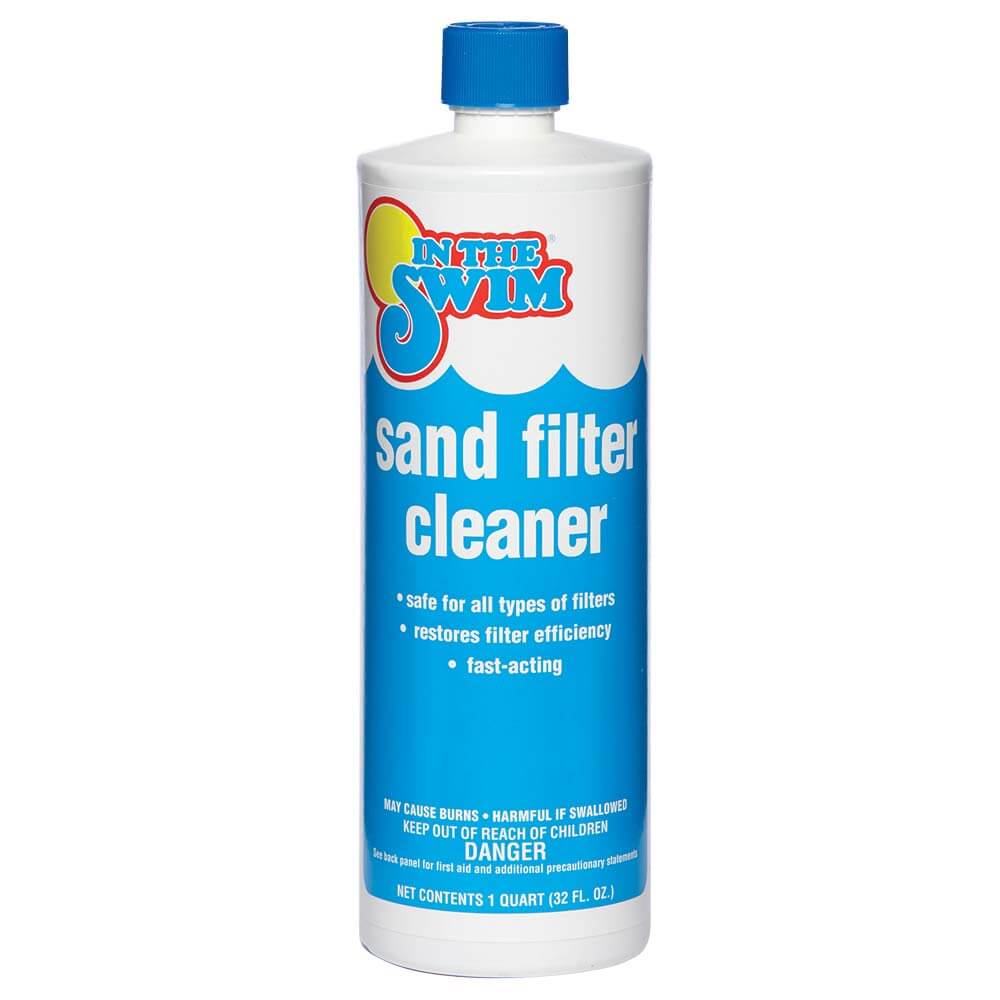
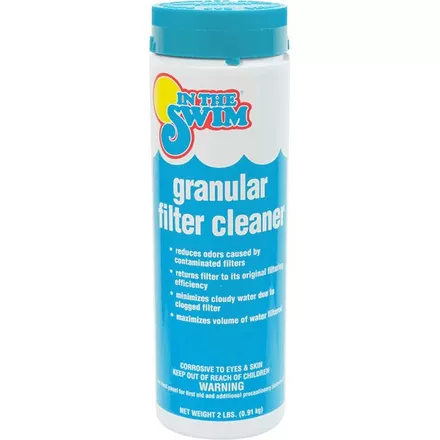
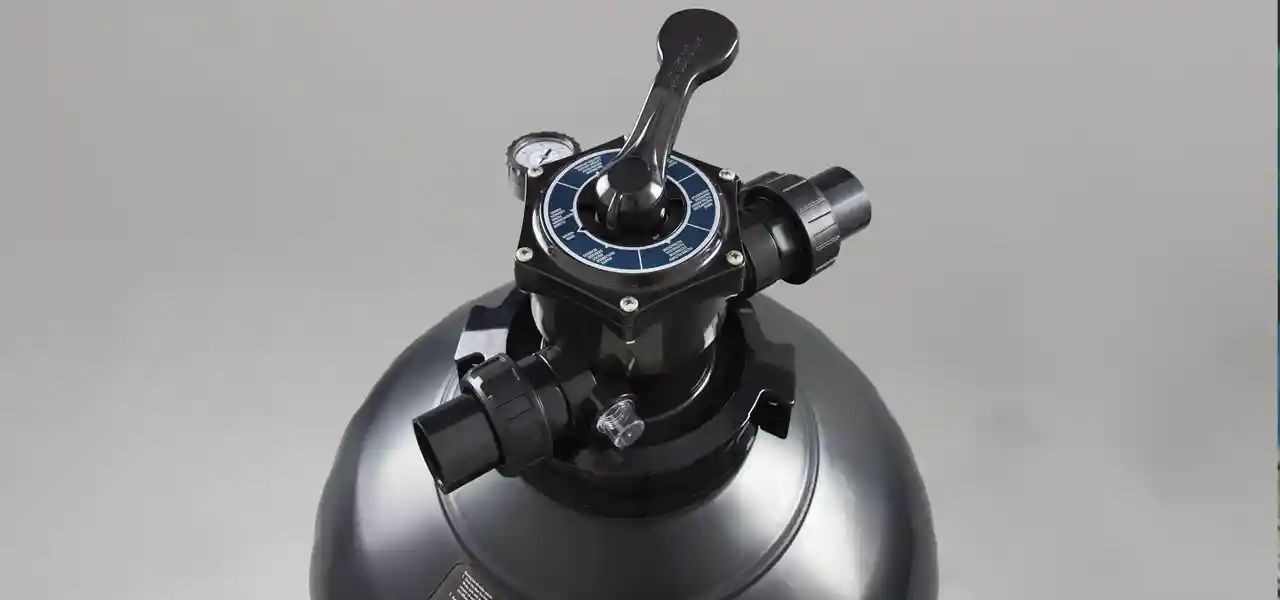
Hi,
I have an inground concrete pool. When my pump is on, should my filtration system be constantly running (constantly sucking water through the skimmer line and constantly returning it) or should it work on waves (suck then return, suck then return) my system used to work in waves, I replaced the old skimmer line with a new above ground skimmer line and now it’s constantly running. Thanks for your time!
Clive, yes it is supposed to be constant, not surging as you describe. Your previous hose may have been collapsing or crimping while under suction.
Call for 4 bags of 50 lbs = 200lbs is what it says on the specs laterals were good but will have to figure it out is there any kind of additional in line filter that I could use in the future as well?
Hi Glen, you could install a secondary filter yes. The simplest way to do it is with a Slime Bag, a heavy filter bag that attaches to your return. For something more permanent, you could install a small cartridge filter, after the sand filter, such as the Jacuzzi J-C150 or the Waterway 150, plumbed in-line – two filters! I like the idea. 🙂 Happy Fourth of July, Glen!
replaced sand in my filter with HTH sand now have sand coming out of outlet alot, never had a problem until I put new sand in, any suggestions? All hayward products S210T filter and 1.5 pump,
I have heard a lot of problems this year with HTH sand, I believe that they may have bagged up some incorrectly graded sand this year and last year. People have reported clogging, and very little flow through new sand, with this brand and others. Sand coming out of the outlet however, could be a different problem, such as adding too much sand, or cracked laterals or standpipe.
I live in Mississippi and I was told that a cartigage filter system in no good because of the humidity and that a sand filter is better… what to do???
Hi Richard, I cannot think of a reason why humidity levels would affect the filter choice. Go with any type that you like. Sounds like some bad advice, I would avoid this pool person in the future.
I have an Intex 1500 GPH pump on a 15ft x 35 in deep vinyl pool. I have great discharge flow, but it doesnt seem to have good suction even with a new cartridge. I used a food coloring test to verify. Any suggestions?
Hi Matt, it stands to reason that the suction flow is nearly equal to the discharge flow, but you may have a smaller orifice on the return or smaller hose that speeds up velocity on the return side. A larger hose or shorter hose on the suction side may increase suction, but not enough to do any vacuuming or anything.
Hi. Thanks for the article. It was intriguing. Our pool has a sand filter and we’ve been struggling with a sandy type substance. After testing multiple times, we’ve had testing results exactly where they should be across the board, which leads me to wonder if there is a filter issue. I routinely backwash and vacuum to waste each day, but when I begin to vacuum the tiny particles move throughout the water and then return again the next day. Is it possible that Alum could be needed in my filter? I have read that many of the smallest particles can pass through your filtration system? Are there any other suggestions that you might have? Thanks in advance for any advice!
Hi Kyle, sand filters will pass thru small particles, as mentioned in the article, there are a few ways to improve sand filtration – first, don’t backwash every day – wait until the pressure gauge builds up to 7 or 8 psi above the clean pressure. Adding a cup of alum or dicalite thru the skimmer will form a layer on top of the sand to trap small particles, until it is backwashed out. Clarifiers are almost always required when using a sand filter, they coagulate smaller particles into larger, more easily filtered clumps. Using the Slime Bag is another good solution to help out small sand filters. Finally replacing the filter sand can help, large inground filters can go 5 or 10 years, but smaller filters (under 24″ dia) may need it every 3-5 years, and much smaller filters may need it every 1-2 years.
When adding alum to the filter via the skimmer are there any other steps needed?
Hi Carl, not really or not in my experience. Just don’t overdose it – one 8 oz cup is sufficient for inground filters, 1/2 cup for small abg filters. Watch the pressure and backwash when needed, replace the alum after if needed again.
How is granular Filter Clean product applied to sand filters? I called In the Swim customer service and they were unable to answer. They also proposed their liquid sand filter product instead.
https://www.intheswim.com/p/liquid-sand-filter-cleaner?pcode=208&scode=SOCIBLOG;
Hi Carl, you pour Filter Cleaners into the skimmer or pump basket, with the filter valve set on backwash. After a few seconds, shut off the pump and let it sit overnight. Label instructions spell out the process
How many bottles of the Granular Filter Clean will I need? Should I use Liquid Sand Filter Cleaner too?
Hi Carl, just one bottle of Granular Filter Cleaner is suitable for most filters and would be best for a deep cleaning. You can also buy the Liquid Sand Filter Cleaner for maintenance doses, “Add 8 oz. of liquid pool sand filter cleaner to your skimmer prior to every backwashing to maintain efficient filtration” – need not be EVERY backwash, but a few times per year, should keep sand filters clear of oils, scale and grimy gunk.
I have a cartridge filter and the guy who did our opening said that he likes to put in some DE powder that will stick to the cartridge and filter the water a little better. Is this correct? Any downside to doing this?
Hi Don, a very small amount won’t hurt and will speed clean-up, as a ‘filter aid’. DE powder can also be used in a sand filter for the same purpose. In both cases, an 8 oz cup would be a suitable measure – more than that and a cartridge filter could possibly be damaged. In fact, I recall a filter manufacturer saying that one should not use DE filter powder or Perlite, because of the very sharp (microscopic) edges which can cut the fibers of the woven cartridge fabric. However, he went on to say, if I recall correctly, that they (or maybe others) tested a cellulose fiber (like PuriFiber), and found that one could use with filter cartridges as a filter aid, without worry. So, the short answer is no, don’t use DE powder in a cartridge filter – but a cup on spring opening likely will not have caused harm.
I have a DE filter on a full that is approximately 40 years of age cartridges are new but it continues to accumulate and I have to clean about every 30 days I am familiar with the E filters that only required to be backwashed sometimes every 60 days some 90 days and feel fear cartridges not to be clean but every 6 months to a year just had a palm tree removed in an oak tree removed can you give me any help on what maybe the cause
Hi Jerrel, a filter cycle of 30 days (or the time between backwashing or filter cleaning), is normal for most pools, or 3-5 weeks. The length of your particular pool filter cycle is directly related to the sizing of the filter, in relation to the pool, and also the age and performance of the filter media (sand/carts). Larger filters have longer filter cycles, and on residential sized pools of 20000 gallons or so, filters can be installed that can go 6 months between cleanings, such as the large 60 SF and 72 SF DE filters, but especially the large 400-500 SF cartridge filters, SwimClear and Clean & Clear Plus.
I have a question. I am renovating a pool (16×32 indoors)- it had a cartridge filter (300sqft). I originally thought it was a sand filter and didn’t look at it that closely. I bought a DE filter. My question is: can I put them inline with the cartridge first and then the DE. Since I already have it I figured why not use it, but I like the filtration of a DE. Thoughts?
Hi, you can use two filters, I have never seen it done before, but they can be plumbed inline, sure – water out of one, and into the other. Double the filtration! This should allow you to run the pump slightly less, or use fewer chemicals perhaps. If you do it, let me know how it comes out, and what benefits you notice
Of course you’ll get the pressure drop of both. Effectively added together in series in your system.
May not be a problem when everything is fresh and clean, but the pressure could cause a flow decrease later.
I like the idea, let the cartridges grab the big stuff, let the DE grab the little stuff. But the cartridges are going to be grabbing what they would normally, so I’d expect their cleaning cycle to remain the same.
The DE might last longer before cleaning cycle – but might not, as the small particles it filters are what cause the flow restrictions.
Now, after my conjecturing, how’d it work out?
Thanks for the tip that if dirt and debris is seeming to make it through your filter than it probably is. I always like to hear common sense solutions to every day issues like this one. It still probably would be a good idea to have a contractor come out and inspect your setup every now and then though.